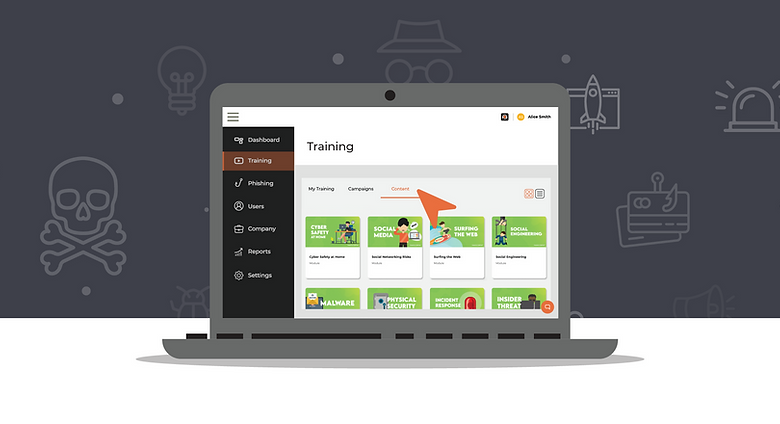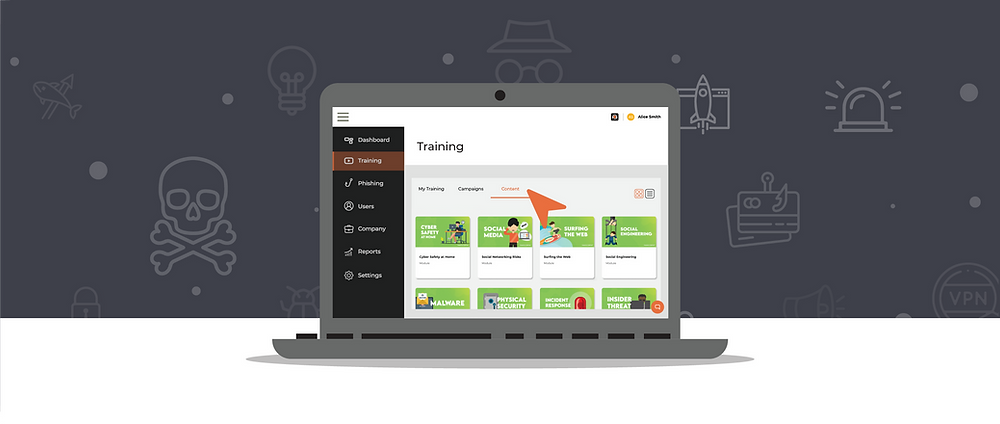
How to Safeguard Your Data Through Security Awareness Training
How to safeguard your data through security awareness training is more crucial than ever in our increasingly digital world. We’re constantly bombarded with cyber threats – from sneaky phishing emails to sophisticated malware attacks. Understanding these threats and learning how to protect yourself isn’t just about tech skills; it’s about developing a security-conscious mindset. This guide will walk you through practical steps, empowering you to take control of your digital security and protect your valuable data.
We’ll explore common data breaches, the critical role of human error, and the benefits of comprehensive security awareness training. You’ll learn practical techniques for identifying and avoiding phishing scams, creating strong passwords, and responding to suspicious activity. We’ll also cover securing your data across different devices and implementing robust data security policies. By the end, you’ll be equipped with the knowledge and skills to significantly reduce your risk of becoming a victim of a cyberattack.
Defining Data Security Risks

Data security risks are ever-present threats that can significantly impact individuals and organizations. Understanding these risks is the first step in building a robust security posture. Failing to acknowledge and address these vulnerabilities can lead to devastating consequences, including financial losses, reputational damage, and legal repercussions. This section will explore the various types of data security risks, their impact, and provide some real-world examples.
Common Data Breaches and Their Impact
Data breaches, the unauthorized access or disclosure of sensitive information, are a major concern. The consequences can be far-reaching. For individuals, a breach might lead to identity theft, financial fraud, and emotional distress. Organizations face significant financial losses from remediation efforts, legal fees, regulatory fines, and reputational damage, potentially leading to loss of customers and business partners. The severity of the impact depends on the type of data compromised and the organization’s response.
For example, a breach exposing customer credit card information will have a far greater impact than a breach of less sensitive data like email addresses.
Examples of Phishing Scams, Malware Attacks, and Social Engineering
Phishing scams involve deceptive emails or messages designed to trick individuals into revealing sensitive information, such as usernames, passwords, or credit card details. These scams often mimic legitimate organizations to build trust. Malware attacks involve malicious software designed to damage, disrupt, or gain unauthorized access to computer systems. Examples include viruses, ransomware, and spyware. Social engineering manipulates individuals into divulging confidential information or performing actions that compromise security.
This can involve techniques like pretexting (pretending to be someone else), baiting (offering something enticing to gain access), and quid pro quo (offering something in exchange for information). A well-known example of a social engineering attack is the 2016 Yahoo! data breach, where attackers used phishing emails to gain access to user accounts.
Statistics on Data Breaches and Associated Costs
The cost of data breaches is substantial and continues to rise. According to IBM’s 2023 Cost of a Data Breach Report, the average cost of a data breach globally is $4.45 million. The report also highlights that the average time to identify and contain a breach is over 200 days. These statistics underscore the importance of proactive security measures and rapid response capabilities.
The costs associated with data breaches extend beyond financial losses, including damage to reputation, loss of customer trust, and potential legal liabilities. The actual cost can vary widely depending on factors such as the size of the organization, the type of data compromised, and the effectiveness of the response.
Types of Data and Sensitivity Levels
Different types of data possess varying levels of sensitivity. Personal Identifiable Information (PII), such as names, addresses, social security numbers, and credit card details, is considered highly sensitive. Protected Health Information (PHI), as defined by HIPAA, is also extremely sensitive. Financial data, intellectual property, and trade secrets are other examples of sensitive data requiring robust protection. Less sensitive data might include marketing lists or publicly available information.
The appropriate security measures must be tailored to the sensitivity level of the data being protected. For example, highly sensitive data might require encryption both in transit and at rest, while less sensitive data may only require access controls.
The Importance of Security Awareness Training
Let’s face it: the strongest firewall and the most sophisticated antivirus software are useless if your employees fall prey to a phishing scam or accidentally download malware. Data breaches are often the result of human error, not technological failure. Security awareness training is the crucial bridge between robust technology and a truly secure organization. It empowers your workforce to become the first line of defense against cyber threats.Human error accounts for a significant percentage of data breaches.
A simple click on a malicious link, opening an infected attachment, or falling for a social engineering tactic can compromise sensitive data and expose your organization to significant financial and reputational damage. The 2022 Verizon Data Breach Investigations Report, for example, highlighted the continued prevalence of phishing attacks and social engineering as leading causes of breaches. These attacks exploit human psychology, preying on our trust and tendency to act quickly without fully considering the risks.
Therefore, a comprehensive security awareness training program is not just a nice-to-have; it’s a necessity.
The Benefits of Comprehensive Security Awareness Training Programs
A well-designed security awareness training program significantly reduces the likelihood of human error-related breaches. By educating employees about various threats and providing them with practical skills to identify and respond to them, organizations can build a more resilient security posture. The benefits extend beyond simple risk reduction; they include improved employee confidence in handling security incidents, increased overall security awareness, and a stronger security culture within the organization.
This translates to reduced costs associated with data breaches, fines, and legal fees, as well as enhanced brand reputation and customer trust. For example, a company that proactively trains its employees on phishing recognition might prevent a costly ransomware attack that could cripple operations.
Different Training Methodologies
Several methodologies exist for delivering security awareness training. Online modules offer a flexible and cost-effective approach, allowing employees to learn at their own pace and revisit materials as needed. Interactive online modules, incorporating gamification elements like quizzes and scenarios, can enhance engagement and knowledge retention. Workshops provide a more interactive learning experience, fostering discussion and allowing for immediate clarification of doubts.
Simulations, such as realistic phishing exercises, allow employees to experience potential threats in a safe environment, reinforcing learning and improving their ability to identify and respond to real-world attacks. The most effective approach often involves a blended learning strategy, combining different methodologies to cater to diverse learning styles and maximize impact.
Key Elements of an Effective Security Awareness Training Program
An effective security awareness training program should include several key elements. First, it must be tailored to the specific needs and roles of employees, addressing the threats most relevant to their daily work. Secondly, training should be delivered regularly, not just as a one-time event, to reinforce learning and keep employees up-to-date on the latest threats. Regular refresher courses and simulated attacks are essential.
Thirdly, the program should incorporate interactive elements, such as quizzes, scenarios, and games, to maintain employee engagement and improve knowledge retention. Finally, it should be measurable; tracking employee participation, performance on assessments, and the overall impact on security incidents provides valuable data for program improvement and demonstrates its effectiveness to management.
Key Security Practices to Teach: How To Safeguard Your Data Through Security Awareness Training
So, we’ve established the
- why* of security awareness training. Now let’s dive into the
- how*. This section focuses on practical, actionable steps you can teach your team to safeguard their data and, by extension, your organization. Remember, even the strongest security systems are vulnerable if users aren’t aware of the risks and best practices.
Password Management Best Practices, How to safeguard your data through security awareness training
Strong passwords are the first line of defense against unauthorized access. Weak passwords are easily cracked, leaving your sensitive data vulnerable. The following table Artikels crucial elements for creating and managing strong passwords.
| Password Length | Password Complexity | Storage Methods | Additional Tips |
|---|---|---|---|
| At least 12 characters, ideally 15 or more. | Use a mix of uppercase and lowercase letters, numbers, and symbols. Avoid easily guessable information like birthdays or pet names. | Use a reputable password manager. Never write passwords down. | Change passwords regularly, especially for critical accounts. Avoid reusing passwords across different platforms. |
Identifying Phishing Emails and Malicious Websites
Phishing attacks are a major threat. These deceptive emails or websites try to trick you into revealing sensitive information like usernames, passwords, or credit card details. Learning to spot these red flags is crucial. Look for inconsistencies in email addresses (e.g., slightly misspelled domain names), grammatical errors, urgent or threatening language, unusual requests for personal information, and links that don’t match the displayed text.
When in doubt, contact the purported sender directly through a known legitimate channel (e.g., their official website) to verify the authenticity of the communication. Similarly, be cautious of websites with unusual URLs or those requesting unnecessary permissions.
Responding to Suspicious Emails or Phone Calls
Let’s say you receive a suspicious email or phone call. Your immediate response is critical. First,do not* click any links or provide any personal information. Second, carefully examine the sender’s details and the content of the communication for any red flags as mentioned above. Third, verify the sender’s identity through an independent channel (e.g., their official website or a known contact).
If you’re still unsure, report it to your IT department or security team immediately. Never assume anything; err on the side of caution.
Reporting Security Incidents
Reporting security incidents promptly is crucial for mitigating damage. Your organization should have a clear and well-defined incident reporting procedure. This typically involves contacting your IT or security team immediately, providing all relevant information (e.g., the nature of the incident, date and time, any suspicious emails or communications received), and following their instructions for further action. Don’t attempt to fix the problem yourself; that could potentially worsen the situation.
Prompt and accurate reporting allows for a quicker response, minimizing the impact of a security breach.
Safeguarding Data on Different Devices
Protecting your data across various devices is crucial in today’s interconnected world. A multi-layered approach, combining robust software and mindful user habits, is essential to minimize risks and maintain data integrity. This section will delve into best practices for securing data on your personal computers and mobile devices, exploring effective security software and safe public Wi-Fi usage. We’ll also examine the critical role of data encryption.
Securing Personal Computers
Effective computer security involves a combination of software and user vigilance. Installing a reputable antivirus program is the first line of defense against malware, viruses, and ransomware. These programs scan files and applications for threats, quarantine malicious code, and often include real-time protection. A firewall, either built-in or a separate application, acts as a barrier, controlling network traffic and blocking unauthorized access attempts.
Regular software updates are vital; they patch security vulnerabilities that hackers exploit. Strong, unique passwords for each account, coupled with multi-factor authentication whenever possible, further enhance security. Regular backups of important files to an external drive or cloud storage are crucial for data recovery in case of hardware failure or malicious attacks. For example, Norton 360 offers antivirus, firewall, and VPN functionalities, while Bitdefender provides similar features with a focus on performance optimization.
Securing Mobile Devices
Mobile devices, such as smartphones and tablets, are increasingly targets for cyberattacks. Similar to computers, installing a reputable mobile antivirus app is essential. These apps often include features like anti-theft capabilities, enabling remote device location and data wiping if lost or stolen. Enabling device encryption scrambles your data, making it unreadable without the correct decryption key. This is particularly important for devices containing sensitive personal information.
Regular software updates are just as crucial for mobile devices as they are for computers, addressing vulnerabilities that could be exploited by malicious apps or hackers. Be cautious when downloading apps, only installing from trusted sources like official app stores. Consider using a strong passcode or biometric authentication (fingerprint or facial recognition) to prevent unauthorized access. Examples of mobile security software include Lookout and McAfee Mobile Security.
Safe Public Wi-Fi Usage
Public Wi-Fi networks, while convenient, pose significant security risks. Unsecured networks are easily accessible to hackers who can intercept your data. Avoid accessing sensitive information, such as online banking or email, on public Wi-Fi. If you must use public Wi-Fi, consider using a Virtual Private Network (VPN). A VPN encrypts your internet traffic, making it difficult for others to monitor your online activity.
Look for networks that require a password; avoid those that are open and unencrypted. Be mindful of the websites you visit; avoid entering sensitive information on sites that don’t use HTTPS (indicated by a padlock icon in the address bar). Examples of VPN services include ExpressVPN and NordVPN.
Data Encryption Methods
Data encryption is the process of transforming readable data (plaintext) into an unreadable format (ciphertext) using an encryption algorithm and a key. Only those with the correct decryption key can access the original data. Several encryption methods exist, each with varying levels of security. Symmetric encryption uses the same key for both encryption and decryption, while asymmetric encryption uses a pair of keys: a public key for encryption and a private key for decryption.
The Advanced Encryption Standard (AES) is a widely used symmetric encryption algorithm, known for its strong security. RSA is a commonly used asymmetric encryption algorithm. Encryption is crucial for protecting sensitive data both in transit (e.g., when transmitting data over the internet) and at rest (e.g., when data is stored on a hard drive). The level of encryption used should match the sensitivity of the data.
For instance, highly sensitive data, like financial records, may require stronger encryption than less sensitive data, such as personal photos.
Data Security Policies and Procedures

Effective data security isn’t just about technology; it’s about establishing clear policies and procedures that guide employee behavior and response to incidents. A robust framework ensures everyone understands their responsibilities and how to react in critical situations, minimizing risk and protecting sensitive information.
This section Artikels essential components of a comprehensive data security policy and procedure framework, including employee responsibilities, breach response plans, the importance of regular audits, and acceptable use policies for company devices and data.
Sample Data Security Policy: Employee Responsibilities
A well-defined data security policy clearly Artikels employee responsibilities. This policy should be readily accessible to all employees and should be regularly reviewed and updated. It needs to be more than just a document; it should be actively integrated into the company culture.
Here’s a sample excerpt illustrating key employee responsibilities:
All employees are responsible for protecting company data. This includes, but is not limited to:
- Using strong, unique passwords and changing them regularly.
- Reporting any suspected security incidents immediately to the IT department.
- Understanding and adhering to the company’s acceptable use policy for all devices and data.
- Protecting physical access to company devices and data.
- Not sharing passwords or confidential information with unauthorized individuals.
- Participating in mandatory security awareness training.
Data Breach Handling Procedure
A detailed procedure for handling data breaches is crucial for minimizing damage and ensuring compliance with regulations. This procedure should clearly define roles, responsibilities, and escalation paths.
A sample procedure might include these steps:
- Incident Detection and Reporting: Any suspected breach should be immediately reported to the designated security team or contact person.
- Initial Response: The security team will isolate affected systems and initiate an investigation.
- Investigation and Containment: A thorough investigation will determine the extent of the breach and implement measures to contain it.
- Remediation: Necessary steps will be taken to fix vulnerabilities, restore data, and prevent future breaches.
- Notification: Affected individuals and regulatory bodies will be notified as required by law and company policy.
- Post-Incident Review: A post-incident review will analyze the event to identify weaknesses and improve future response capabilities.
Importance of Regular Security Audits and Assessments
Regular security audits and assessments are vital for identifying vulnerabilities and ensuring the effectiveness of existing security measures. These assessments should encompass both technical and procedural aspects of data security.
Audits can uncover hidden risks, confirm compliance with regulations, and provide a baseline for continuous improvement. They should be conducted by internal or external security professionals with appropriate expertise.
So, you’re building robust applications? That’s great! But remember, even the slickest domino app dev the low code and pro code future solutions are vulnerable if your team isn’t security-aware. Investing in comprehensive security awareness training is crucial; it’s the best way to ensure your data remains protected, no matter how innovative your tech stack becomes.
Acceptable Use Policies for Company Devices and Data
Acceptable use policies (AUPs) define how employees are permitted to use company devices, software, and data. These policies should be clear, concise, and cover various aspects of data usage, including internet access, social media, and data storage practices. Enforcement is key to the policy’s effectiveness.
AUP examples often include restrictions on downloading unauthorized software, accessing inappropriate websites, and sharing confidential information. Failure to comply can result in disciplinary action.
Ongoing Training and Reinforcement
Security awareness training isn’t a one-and-done affair. To truly embed secure practices into your organization’s culture, ongoing reinforcement is crucial. Think of it like brushing your teeth – you wouldn’t just do it once and expect perfect oral hygiene for life. Consistent effort is key to long-term success. This means implementing strategies to keep security top-of-mind and continually update employees’ knowledge and skills.Regular reinforcement helps combat the “forgetting curve,” that natural decline in knowledge retention over time.
Without consistent reminders and refresher training, even the most engaging initial session will eventually fade. By regularly revisiting key concepts and introducing new threats and best practices, you build a resilient security posture that actively adapts to the ever-evolving threat landscape.
Methods for Reinforcing Security Awareness Training
Effective reinforcement utilizes diverse methods to cater to different learning styles and maintain engagement. A multi-faceted approach is far more effective than relying on a single tactic. This approach ensures information reaches and resonates with every employee, irrespective of their learning preferences.
- Regular Email Updates: Short, informative emails highlighting recent security incidents, new threats, or best practices for specific scenarios (e.g., phishing scams, password security). These should be concise and actionable, focusing on a single key takeaway.
- Short, Targeted Training Modules: Instead of lengthy annual sessions, consider delivering shorter, more frequent modules focusing on specific topics. This allows for better absorption and reduces training fatigue.
- Interactive Workshops and Simulations: Hands-on activities, such as phishing simulations or tabletop exercises, provide a valuable learning experience by placing employees in realistic scenarios.
- Team-Based Challenges and Competitions: Gamification can significantly boost engagement. Teams can compete to identify phishing attempts or solve security puzzles, fostering a collaborative and fun learning environment.
Engaging Training Materials
The key to successful reinforcement is engaging content that captures attention and facilitates learning. Boring presentations and lengthy documents are counterproductive.
- Short, Animated Videos: Videos explaining complex concepts in a simple, visually appealing manner can significantly improve knowledge retention compared to text-based materials. For example, a short animation depicting a phishing attack could be far more memorable than a lengthy email.
- Infographics: Visually summarizing key security practices, like password strength or two-factor authentication, helps employees quickly grasp important information. A visually appealing infographic on password best practices is more likely to be remembered than a lengthy written document.
- Interactive Quizzes and Games: Regular quizzes and games test employees’ knowledge and reinforce learning in a fun and engaging way. A simple quiz on recognizing phishing emails can effectively test knowledge and identify areas needing further training.
Regular Updates and Revisions to Training Materials
The threat landscape is constantly evolving. What was considered best practice last year might be outdated today. Regularly updating training materials is vital to ensuring employees receive the most current and relevant information. This ensures that the training remains effective and relevant, keeping up with the latest threats and vulnerabilities. This should include addressing emerging threats and incorporating lessons learned from recent security incidents.
Gamification in Security Awareness Training
Gamification can significantly enhance engagement and knowledge retention. By incorporating game mechanics such as points, badges, leaderboards, and challenges, you can transform security training from a tedious obligation into a fun and rewarding experience. For instance, a points-based system rewarding employees for correctly identifying phishing emails or completing security training modules can encourage active participation and continuous learning.
Leaderboards can create a healthy sense of competition, while badges can provide recognition for achievements, boosting morale and promoting a culture of security awareness. This approach transforms a potentially dry subject into a more engaging and memorable experience.
Final Thoughts
Safeguarding your data isn’t a one-time task; it’s an ongoing process that requires vigilance and continuous learning. By implementing the security practices Artikeld in this guide, and by consistently reinforcing your security awareness, you can significantly strengthen your defenses against cyber threats. Remember, the most effective security measure is a well-informed and proactive individual. Stay vigilant, stay informed, and stay safe online!
Essential FAQs
What are the legal implications of a data breach?
Legal implications vary widely depending on the type of data breached, the applicable laws (like GDPR or CCPA), and the organization’s response. Penalties can include fines, lawsuits, and reputational damage. It’s crucial to consult legal counsel if a breach occurs.
How often should security awareness training be updated?
Security awareness training should be updated at least annually, and more frequently if there are significant changes in technology or threats. Regular refresher training helps keep employees informed about the latest threats and best practices.
What are some examples of engaging training materials?
Engaging training materials include short videos, interactive quizzes, simulated phishing attacks, infographics, and gamified modules. Variety keeps training interesting and effective.
Can small businesses afford security awareness training?
Yes, many affordable options exist for small businesses, including online modules, webinars, and even free resources. The cost of a data breach far outweighs the investment in training.





